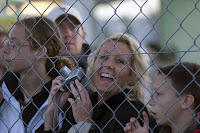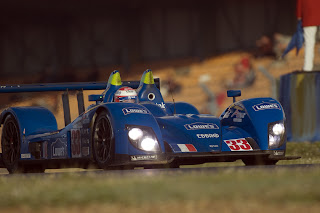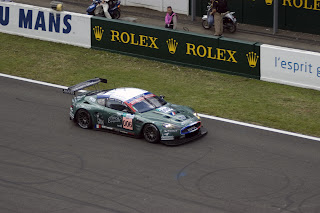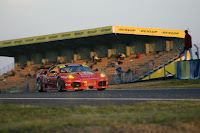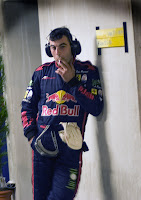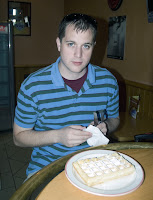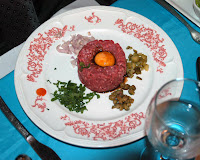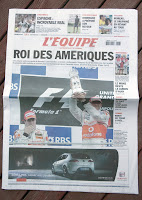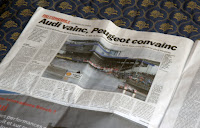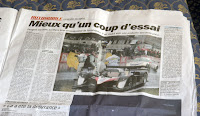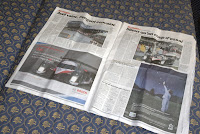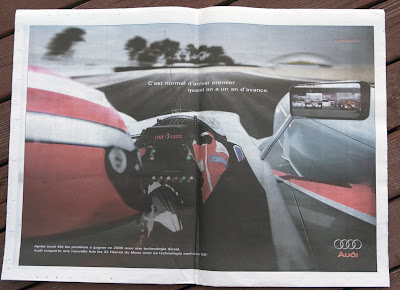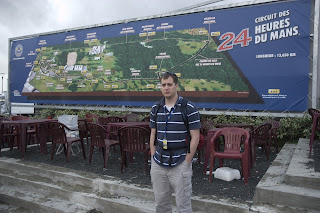One of the treats for me at Le Mans was having Laurent Charniaux sit next to Joe and I in the press room. In our short stay at Le Mans, our view of the world was changed in many ways -- but one of the best things was getting to know this photographer.
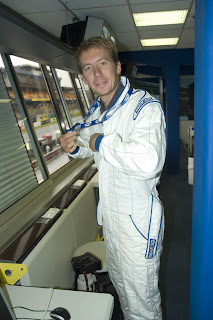
We did not know each other from Adam when I arrived Thursday morning. Laurent is a handsome Frenchman (actually he may be Belgian, so I hope that he is not offended by being called French like Hercule Poirot) with clear eyes and a ready smile. He is tall and lithe and when dressed for the track (at left) it would be easy to mistake him for a driver, except for the load of cameras he is carrying.
He is also a heck of a race photographer. I have worked with and around some really wonderful photographers in my time on this earth -- all very talented. However, it was really amazing to see the work that he created at Le Mans. The challenge of covering Le Mans is that it is a week long event -- with the race lasting 24 hours -- and if you are really going to cover the event, there is not a great deal of time to rest during those final 24 hours. To cover this event requires the endurance of a marathon runner as well as the soul of an artist. Laurent has both
Laurent lives in Avignon, France and spends around a third of year chasing a variety of racing events -- mostly on the high profile
Formula One Circuit. As this story is being posted, Laurent is in Budapest, Hungary covering the latest race for that series. Over the last month he has been gracious enough to take time from his schedule during the hectic Formula One schedule to answer the following questions. Here is a view of the world of photography and in particularly race photography from a veteran in the business:
In taking a peek of the images that you produced at Le Mans, I see a definite passion in your work. I am wondering if this passion is a passion for the cars or a passion for photography?It’s a passion for both cars and photography.
To be honest I was first a big fan of motor sports as I was karting driver in Belgium and also drove in the Benelux championship when I was 16 to 20 years old. When I understood I was not good enough to be a driver, I decided to stay in this “world” and I decided to learn photography because it was my other passion for years and years.
Tell me how your life’s journey led you to the field of photography. If you were not a photographer, what would you be doing?
I have never thought about that before, I love photography and I don’t want to do something else.
What is it about photography that makes you so passionate about it?
I don’t know exactly; I like to think I keep for eternity a moment that exists for a tenth of a second. It’s like fixing the time. It’s great to see something nice and keep it forever.
Do you have formal training in photography or did you learn like many – from just doing? Do you have other educational background (college or university?)
I learned photography in a art school in Brussels but I stopped one year before the end because somebody offered me a job. Then I started to work as photographer full time.
Did your time in college result in a degree? If so in what subject? It does not really matter except that students need to know that while there is an advantage to having a degree, if they have the passion, the will, and the drive, they don’t necessarily need a degree to be a photographer. For example Henri Cartier-Bresson studied formal art (painting and sculpture) before turning to photography. His background in art I am sure helped him as a photographer – but even without it I think he would have become a great photographer because of the person that he was.
It’s difficult to know, but from my point of view I think doesn’t mater what kind of study we did. If a student becomes an “arty” photographer maybe it’s helpful to have a formal art study as Henri Cartier-Bresson. But I’ve other examples, may be you know
Jan Arthus Bertrand who is a fantastic photographer. He makes very famous books as “The Earth from the Sky”. This guy is a very talented photographer and he never studied photography, art, or something like that He just learned everything by himself. I think the most important way to become a photographer is to love photography.
 As you have developed your style as a photographer was there another who served as a mentor for you? If so, can you tell me about how you met this person and how your relationship with this person worked?
As you have developed your style as a photographer was there another who served as a mentor for you? If so, can you tell me about how you met this person and how your relationship with this person worked?I developed my style by myself. I’m developing it just to try to do different pictures of the others guys. For example on a race track I try to never go in a place where other photographers go. (
Editor's Note: At Le Man, access to the track is controlled by the issuance of both a press credential and a colored vest or dickie that photographers are required to wear. Pink is general access to the track and Yellow is access to the pit area, where you must also wear a driver type fire suit. At left is a hole cut in the fence trackside where photographers are stacked up; it is a place where you will seldom find Laurent.) But I had a mentor too who taught me everything about digital photography

. He was one of the leaders on Moto gp circuit in the eighties; his name is Yves Jamotte. I worked for him during years doing F1, Moto GP and Superbike. One day he saw my F1 pictures in some magazines and phoned me to offer me a job. At this time it was the beginning of the digital photography era and he was one of the first to believe in this new technology. I didn’t know anything about digital and he explained everything to me. Some years ago he died but I’m always thinking about him when I’m editing my pictures.
(At right, Laurent checks the map of the track at Le Mans in preparation of his next on-track session.)
It seems to me that having a strong background in film photography is an advantage when you switch to digital. Do you agree? Was it an easy transition for you?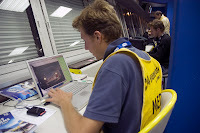
I think you are right and I agree with you. The basic and most important thing in photography is how to use the light. Using film or transparencies is a fantastic way to learn the uses of light because you have no way to right the error. (At left, Laurent downloading images in the press room.) If you under expose or over expose your images, your work goes straight to the bin. A lot of people tell me I’ve some different pictures because “my” light is different; I’m sure it’s because I used films for many years. Photographers who never used film think with digital we don’t need to pay attention to the setting of the cameras and exposure because they work on their pictures with Photoshop and they think Photoshop can correct everything -- but it’s not true. Even in digital photography you must take care to light each picture properly. I’m one of the last photographers in F1 to use a light meter and I’m sure it’s good because even in digital if you make a mistake with the exposure it’s not so easy to correct it. Your pictures must be good without any Photoshop correction.
It was not so easy to make digital photographs in the beginning. It’s not really different when you make pictures but the work after an event is completely different. In the past after an event you processed and sent the transparencies and job was done. Now

with digital the most important thing to selling your images is speed. Not after the event but sometimes just after we made some images (at right Laurent is working with a client on images that he had just downloaded from the race), especially if it’s some important pictures or photos of something that we have exclusively -- then we need to send them to a potential client very very quickly. Then you must be good using computer, using internet site ... It’s no longer just a photographer's job, it’s a data processing job as well. Sometimes you don’t have time to concentrate on making a nice pictures and that’s not so good but that’s the way it is with modern time, everything must be fast.
Do you have other photographers (or other artists) whose vision you admire; perhaps who may inspire you to look at things differently?In motor sports I’m a big fan of French photographer
Bernard Asset who started in F1 photography at the end of the seventies. He was one of the first to shoot with very low speed and his pictures still look great 30 years later. He’s still doing F1 photography working for Renault Team and he’s a big friend of mine (he was at le Mans sitting close to us). To be honest it’s difficult for him now because of the switch to digital photography. I’m also a big fan of Jan Artus Bertrand as well who is one of the most talented wild life photographers today.
In our brief time together at Le Mans, you mentioned that you normally are covering Formula One and that this was the first time in seven years (I think) that you had missed the US event at Indianapolis. How do you cope with all the traveling? Between jet lag, taking care of clients, and just staying sane – how do you do it?It’s not so difficult because I do only F1 and some big events such as Le Mans, Indy 500 and some
World Rally Championship events (WRC). It’s maybe 20 to 22 events in one year then I’m really often at home. Between F1 GP I’ve about ten days to take care of the clients and my family. About Jet lag, after ten years of travel I’ve no problem about it, it’s usual for me. When I’m traveling I try to be cool and relax and enjoy free times in plane to read and listening music.
That kind of segways into the whole issue of family and such. I assume that you are single – but either way with this kind of a travel schedule how do you manage a social life, whether it is with your family or just hanging out with friends. What do you do for a hobby to get away from making pictures?Once again between F1 GP events I’ve a lot of time to meet my friends, family, and spend time with my girlfriend. My girlfriend and me are living together for two years now and we are thinking about getting married.
It appears to me that Le Mans is a one-of-a-kind event with respect to the commitment that it takes for coverage. How much time did you take off the following week to recover?
Le mans it’s a difficult event because you work one week with hard schedule but after one day cooling out at home enjoying free time I was ready to start a new job.
Covering car racing is pretty cool – I mean how many people would love to get paid to attend the greatest racing events in the world – but from a business perspective do you find that you have to have other areas of commercial work to sustain your business financially? If so, what other areas of photography do you work in? Is there an area where you are experimenting and want to try commercially?
To be honest, in the beginning it was hard. When you start in this world, I mean motor racing pictures, it’s not so easy to get clients and photographers in the place don’t like to see a new guy arrive in the business. I need about five to six years to earn “good money.” Now, I’m quite lucky because I get some good deals, I work with a very good agency and I’ve a “name”. People know my work and my style it’s easier to get work. Now people call me to offer me some shooting assignments when some years ago I phoned them to try to get work.
Do you have a favorite image or series of images that you have made? Tell us why they are memorable to you?
I’ve some, often I like a picture because it’s technically a difficult shot and I succeeded. I like as well a picture that means something important. Example I’ve some very nice shots of Alonso when he won his first Formula One Championship in Brazil two years ago. I was in a different place than the other photographers when he came back to the pits after the race. He climbed on his car, removed his helmet in a terrific silent moment and he looked in front of him to me and began to shout. These pictures are mega because I’m the only one to get them; they mean something to me that is as important as news pictures and it’s great to see the determination and the pride in his eyes. Other example I’m very proud of are some pictures I made of Raikkonen overtaking Fisichella on the very last lap of the Japanese GP in 2005. I was the only one there, the light was incredible because it was end of the day light in Asia; we can see the two cars side by side in the light with a great black background. Once again I like these pictures because I’m the only one to get them and it was “the moment” of this race.
One of the things that many people do not understand about photography is the commitment to equipment that is required; while it is true that photographers make pictures and the camera is just along to facilitate the vision of the photographer – what equipment do you use. How did you choose the equipment that you use? What do you typically take with you to an event? How is flying with equipment these days?
I use Canon because for me it’s the best equipment at the moment. I think Nikon is quite close to Canon but Canon is leading in terms of quality and digital bodies. In an event I use two bodies (Mark II and a new Mark III), some lenses: 15mm, 16 to 35mm, 70 to 200mm, 300mm and a 500mm. For traveling I’ve no problem for the moment, I take as carry-on luggage my bodies, some lenses and my Mac.
Have you ever missed “the shot” that you needed to get?
Yes of course it happened but not these last years. I missed some shots when I worked for Yves Jamotte at the bike races. At this time I had no experience and I had to make pictures both in digital and film. It was very difficult. Some clients wanted some pics on digital and others on film, you can imagine how difficult it was. Of course sometimes I missed an important moment during race. But I have learned so much since then; Yves was a very nice guy for the most part, but work was work and when I missed some pics he was very angry with me. Now with the experience, it’s very rare when I miss a shot when I’m in place. It’s really motivating to get something that the other photographers miss; that’s when I know that I’m really concentrating on my work. (Editors note: At the race in Germany this year, just after the start of the race, there was a virtual downpour of rain. Laurent noted of his experience there: "I hope the race [in Hungary] will be more dry than Germany... But it was a fantastic race, my pictures were not too bad but I didn’t make the good choice (for location) and I was not in the good spot but as you know it’s impossible to make the good choice on every race.")
How do you market yourself? I see that you are representing by the prestigious Image Bank organization. How did that relationship come about and what other things do you do to continue to find new clients and keep old clients? Have you ever been “burned” by a client – if so can you tell us the particulars and the resolution? Any advice to folks to keep from having a problem business wise?
For the moment I have been able to keep my clients; but I also cross my fingers. Now I’ve some “long term” clients that I keep for myself and the agency I work for manages all the new clients and all the business part of my work; I get part of the money they sell in addition of my monthly fee.
How have you developed your relationship with race sites? I ask this because getting access to the course and the pits is critical for you to do your job and many sites are unwilling to give an unknown freelancer that opportunity to make pictures without an assignment.
Once again it was hard at the beginning but when press people of tracks and teams begin to know you, and they know you are serious, and photography is a real business for you, then life becomes a little easier; normally I do not have anymore big troubles getting a pass.
I would assume that you have assignments to cover these events from either magazines or teams? Do you ever cover a race without an assignment prior to getting to the event?
Yes but when I was young and rookie in the job I went to events without a pass and sometimes only with a spectator ticket. I tried to make pictures from the grandstands or paddock. It was good fun because I had no pressure.
Do you make pictures of other subjects just for your pleasure? If so what are the subjects?
The part of France where I’m living (Avignon), is one of the beautiful parts of the world. I really like to make pictures there. When I’m
traveling I always carry a body and a 50mm. I really like to walk in a foreign city making pictures.
Do you have a favorite venue (track or event)? What is it and why do you like it?
I like some F1 events such as the Belgian GP, the Japanese GP, the Monaco GP, the British GP, and the Italian GP. I like old tracks, where there is a history. I really love the Le Mans 24 Hour race and some WRC such as Monte-Carlo, once again because there is a fantastic history on these events.
I think that one of the things about racing is that after going to the same race for five or six years it is easy for the track to become too familiar; How do you keep your approach to tracks and events that you have covered each year for several years fresh? Do you find that difficult?
To be honest it’s very difficult sometimes to find new spots. That’s why I try to go where I’m alone because for sure it will be able to make a different shot; but sometime it’s different but a crappy shot. Or sometimes I go to some places with different lenses and then you make different shots. For some tracks it’s very difficult to find new angles -- but not impossible; For example: the track in Barcelona is the track I have shot at regularly because teams do a great deal of winter testing there. All the teams spend so much time there testing new cars and new drivers during the winter. I cannot see this track anymore now, but last winter I stopped at a corner that normally I’ll never stop at in the the years before -- and I found some really nice spots especially at the end of the day when the light was nice. A lot of people asked me where it was because they never saw these shots before in Barcelona. To be honest I was very happy with these images.
I am sure that if you are somewhat close to the various teams you get to meet owners, crew chiefs, and drivers. Do you have to distance yourself from these folks since you are covering these folks journalistically or have you become friends with some of the drivers? (maybe at the F-1 level this does not happen.) Does this affect your coverage of events?
It’s really difficult to be “real” friend with a driver. For example for the moment in F1 I was working in the sport before 19 of the drivers were even in F1. When I made pictures of them in Formula Renault, Formula 3 and GP2 all these guys were really nice, funny and I had so much fun with them at parties and restaurants; but when they are in F1 everything is different. They have so much pressure, they become “stars” and then the relationship is very different. During winter testing it’s more relaxed and sometimes you have some nice chat with a driver but that’s it. To be honest I think it’s better like this.
What background do you have in business? Most photographers that I know have always had “the eye” but most struggled to make photography in a business. How do you deal with these issues?
If you really want to make a business with your passion it’s possible. I know it looks not so easy but it’s true. So many times when I started I was close to stopping and thinking about doing something else -- but I have always believed in me and in my opportunity -- and now I make good money with my passion. It’s great!
But has it been difficult for you to combine the passion of your art with being a good businessman. It would be great if we were all wealthy and could just make pictures for the sheer joy of the process. But at the end of the day, we have to pay for rent like everyone else? Is there any hints that you give to photographers starting out about being good businessmen and women?
Difficult question. It’s not easy to be a good businessman and to be honest I’m afraid I’m not a very good one. Of course I’m able to sell my pictures and I’m able to contact the right people with teams, tracks, and publications. Now Today it’s more easy because people know me. But as every job, you must learn how it works. At the beginning I was afraid to contact people and show what I’ve done during my reportage but as you said at the end of the month you must pay your travel costs, your apartment, your car. Then you’ve no choice you must do it. When you are obliged to do it, you learn quickly.
My most important problem was, when I was starting as photographer, I never had the feeling I had a "real job” and that’s not good. In the beginning, money was not my priority. I was happy to be at Monaco, Indianapolis or Le Mans and I didn’t think about the sales. I just enjoyed the moment. Very quickly when bills arrive you come back to reality. I learned a lot since these times and now I go to an event only if I’m sure of the sales my pictures or if somebody has offered me good job at this event. For sure sometimes business is more important than the fun, but that’s the way it is.
How important are good people skills to you as a photographer? By that I mean that you have deal with people with regularity – other photographers, media people, team managers, track media, and of course track guards. It’s very important to work with people who know their job well; In Formula One all the photographers who get a permanent pass for the year, know the job and the way it works and there is no problem. We have sometimes problem with photographer who covers a single event because he doesn’t know the rules and how it works and very often you miss a shot because the guy suddenly stands in front of you. I can understand when you arrive in a foreign “world” as Formula One sometime is -- it’s not easy to understand everything quickly, it can happen.
Press officers are very important in my job. When you work with a team, a sponsor, or a driver, you need to be in good relation with them. For example the team’s press officer is able to give you the opportunity to go to the box with the team and the driver to shoot something special. He must understand what you need and how to help you. There are some really professional PR people, in which every request is understood and we have no problem to complete the job; unfortunately sometimes you have some bad PR people and then everything is so difficult that you become crazy. If the guy decides not help you, it’s very difficult to get what you need and after that you must explain to the client you don’t have the shot he wants but you know the client doesn’t care about the reason.
Sometimes even some journalists don’t understand how difficult is it to get some shots. One day one of them asked me to make some technical shots of the McLaren. Body works, front wing, rear wings are not the problem but he ask me some pictures of the gear box, engine, suspension. It’s just impossible because all these parts are really protected by the team as top secret parts. The journalist never understood why I was unable to give him the shots. He was new in F1, he came from Formula 3 where everything it’s possible and thought it was the same in F1.
If someone was starting out in photography today (after say two years in school studying photography) what advice would you give to them?
He or she MUST believe everything is possible and he can do it; but he must also be ready to have bad times too. The most important thing in this business is to get a “name”. Then he must try to make different shots using different lenses, going to different places and taking a risk.
I remember my friend
Yves Jamotte (the photographer I talked about before) explained to me some years ago: “If you really want to make good money in this fucking crazy job, you must do everything to stay in the business; you must be good at each event you cover, you must be fair with all the other photographers and clients, and you must be patient because it’ll take about ten years to achieve your goal. “
He told me that in 1998 and he was right. Just one thought he forgot to tell me and I would like to add, you must take a lot of pleasure when you work, you must enjoy looking for new shots, you must enjoy photography.
 FARNHAM, SURREY, United Kingdom (Retrospectively via telephone) – In the 75 years that Le Mans has been running as a 24 hour race, the best finish by a woman has been a fourth place by Frenchwoman Odette Siko in 1932. Californian Liz Halliday, the only woman to drive in the 75th running of the 24 Hours of Le Man version of the aims to change that. She wants to win it all.
FARNHAM, SURREY, United Kingdom (Retrospectively via telephone) – In the 75 years that Le Mans has been running as a 24 hour race, the best finish by a woman has been a fourth place by Frenchwoman Odette Siko in 1932. Californian Liz Halliday, the only woman to drive in the 75th running of the 24 Hours of Le Man version of the aims to change that. She wants to win it all.





